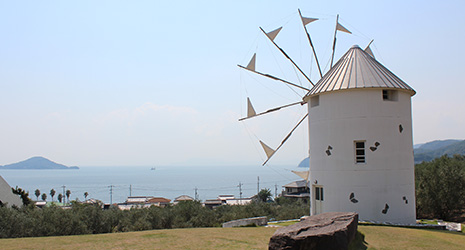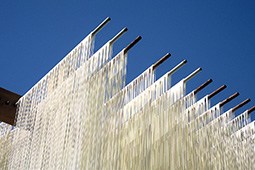INDEX
- English
- 日本語

The view from Shodoshima Olive Park overlooking the windmill on Shodoshima, Kagawa Prefecture - English
- 日本語

Olives of Shodoshima, Japan’s largest olive-producing region

Spectacular view of Kankakei Gorge created by unusual rock formations and precipices 
Tenobe Somen drying in the sun 
David Carroll at his hamburger restaurant in Shodoshima
November 2021
Island of Olives and Soy Sauce

The Seto Inland Sea is the largest inland sea in Japan and is home to over 700 islands, large and small. Among them is Shodoshima, which boasts stunning scenery and is known as a major production area of soy sauce and olives.

Shodoshima in Kagawa Prefecture is the second largest island in the Seto Inland Sea, after Awaji Island in Hyogo Prefecture. The island has a circumference of more than 100 kilometers and a population of around 26,000 (as of September 2021). Transportation between Shodoshima and the mainland is almost exclusively by ferryboat, taking about 60 minutes by ferry or about 35 minutes by high-speed boat from Takamatsu Port in Kagawa Prefecture.
“Shodoshima has flourished as an important port of call for maritime traffic since ancient times,” says Shodoshima Tourism Association director Shiode Shingo. “As well as being surrounded by beautiful sea, the island’s interior is home to one of the most magnificent gorges in Japan, Kankakei Gorge, with its dramatic scenery created by precipices and unusual rock formations, and to Hoshigajyo Mountain, which at 817 meters above sea level is the highest mountain in the Seto Inland Sea. The appeal of Shodoshima is the abundance of natural features that such large islands can offer.
One of Shodoshima’s main industries is soy sauce production, which dates back to the first half of the seventeenth century. Production of salt, a soy sauce ingredient, flourished and although production capacity for the other ingredients of soybeans and wheat was small in scale, it was easy to ship in supplies. Moreover, products could easily be transported to the commercial center of Osaka, and this is said to have led to the island becoming a major soy sauce production area.
To this day, many Shodoshima soy sauce breweries still produce soy sauce in the traditional way using wooden vats.
“Unlike today’s tanks made of materials such as stainless steel, wooden vats allow yeast and other microorganisms found in the brewery to penetrate the soy sauce, so each brewery produces a different flavor, even if they make it in exactly the same way,” explains Shiode.
Other Shodoshima specialties are tsukudani, made by cooking kelp and other ingredients in the island’s specialty soy sauce, and tenobe somen, traditional ultra-thin dried noodles made from only wheat, salt, sesame oil, and water.

Another well-known product of Shodoshima today is olives, which have been cultivated since the early twentieth century. The island’s temperate climate, with relatively little rainfall and an average annual temperature of 15 degrees Celsius, makes it ideal for olive cultivation. Shodoshima is now the largest producer of olives in Japan, earning it the nickname “Olive Island.” The Shodoshima Olive Park is an olive-themed park with some 2,000 olive trees and featuring a white windmill built as a symbol of friendship between Shodoshima and its sister island of Milos in Greece. The spectacular view created by the greenery of the olive groves against the backdrop of blue sky and blue sea make it the most popular sightseeing spot on the island.
The most notable feature of Shodoshima olives is that “the olives are entirely hand-picked,” says Shiode.

“Because they are grown on narrow slopes, the work can’t be mechanized, so each olive is individually picked by hand and the fruit doesn’t get damaged. Selecting only the best fruit and pressing it on the island while still fresh produces a high-quality olive oil. I recommend olive oil and salt with the local specialty tenobe somen noodles.”
There are some who have moved from the city to this island full of charms. One such person is David Carroll from Australia. After coming to Japan in 2016 with his Japanese wife, David had been living in Nagoya City, Aichi Prefecture, the central city of the Chubu region, where he taught English. He fell in love with Shodoshima after visiting the island on vacation, eventually moving there with his wife in 2019. “We decided to move to Shodoshima because it’s a very beautiful island. You can enjoy all the beauty of nature here on one small island—beautiful forests, mountains, and crystal clear sea waters,” says David.

David opened a hamburger restaurant on the island, and it has become popular with locals and tourists alike. When his busy work schedule allows, as a pastime he enjoys fishing and touring the island by motorcycle. “There’s an abundance of nature and the food is wonderful. The people are kind too. We can enjoy a truly perfect lifestyle here,” says David.
Shodoshima is a beautiful island that is ideal for those who want to enjoy the sea, the mountains, and the food in a mild climate.

